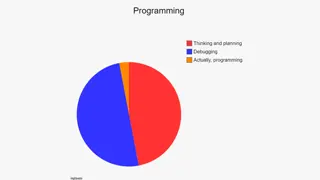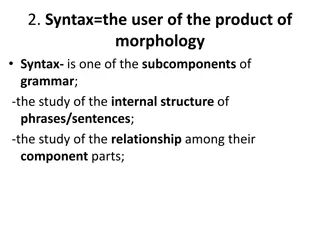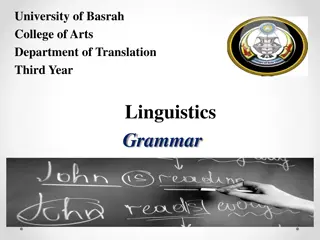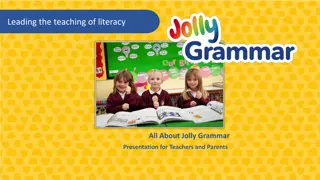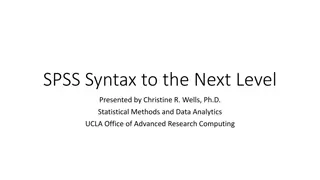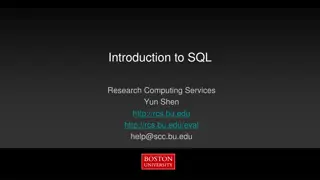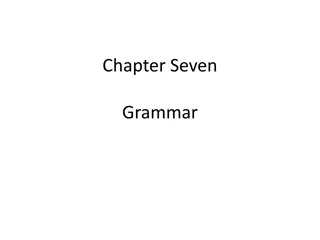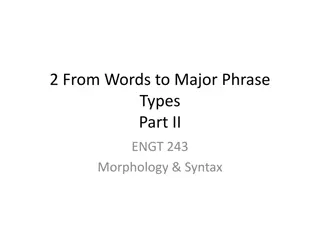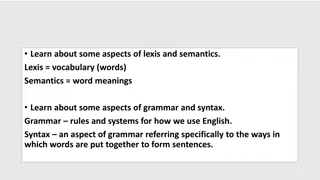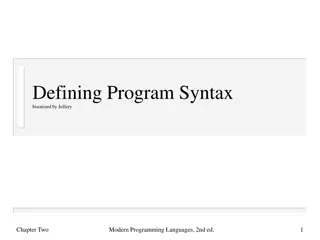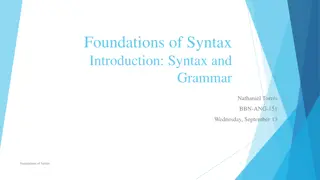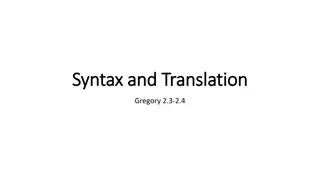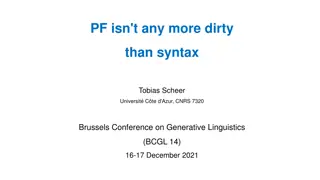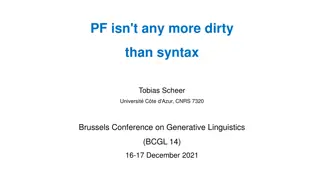Understanding Syntax in Theoretical Grammar
Syntax, as a branch of theoretical grammar, explores the combination of words in phrases and sentences, focusing on their relationships and functions in communication. Basic syntactic notions, such as syntactic units, syntactic meaning, and syntactic relations, play a crucial role in shaping the structure and understanding of language.
Download Presentation

Please find below an Image/Link to download the presentation.
The content on the website is provided AS IS for your information and personal use only. It may not be sold, licensed, or shared on other websites without obtaining consent from the author. Download presentation by click this link. If you encounter any issues during the download, it is possible that the publisher has removed the file from their server.
E N D
Presentation Transcript
SYNTAX AS A BRANCH OF THEORETICAL GRAMMAR
Outline 1. Basic syntactic notions. 2. Types of syntactic relations. 3. Classification of phrases. 4. The sentence. Characteristics of the sentence. 5. The parts of the sentence.
Syntax studies the ways in which words are combined in phrase and sentence. deals with the external functions of words and their relationships to other words in the phrases, sentences and texts. concerned with peculiar features of syntactic units, their behaviour in various contexts.
Basic syntactic notions: Syntactic unit a combination which comprises at least two constituent parts: a phrase, a sentence and a text. possesses the following major features: - hierarchy (i.e. the units of a lower level provide the building material to create the units of a higher level); - a two-fold nature: an expression side and a content side = syntactic form and syntactic meaning. - a communicative and a non-communicative nature (i.e. phrases have a non-communicative nature whereas the sentences and texts have a communicative nature).
Basic syntactic notions Syntactic meaning is the way in which specific word meanings are combined in order to produce meaningful phrases and sentences. Grammatically the sentence Green ideas sleep furiously is quite correct; however it makes no sense because this sentence is devoid of syntactic meaning. Syntactic form is the distributional pattern of the unit: The policeman stops the car. N1 + V + N2. Syntactic function may be described as relationship of one constituent to another within a syntactic construction (a clause/a phrase, e.g. a long story - the word long is in subordinate attributive relations to the head element). Syntactic function of a unit in a sentence - object, subject, predicate, etc. is the grammatical
Basic syntactic notions Syntactic relations may be described as syntagmatic relations which are observed between syntactic units. In accordance with the types of syntactical connection between the components, syntactic units can go into 3 types of syntactic relations: Coordination syntagmatic relations of independence. - observed on the levels of phrase, sentence and text. - symmetric - characterized by the possibility of complete interchangeability of its elements, e.g. cats and dogs. - asymmetric - the elements have a fixed position, e.g. ladies and gentlemen. - types of connection may be copulative (he and she), disjunctive (you or me), adversative (small but comfortable) and causative-consecutive (on the sentence and text levels only).
Basic syntactic notions Subordination syntagmatic relations of dependence. observed between the constituent parts having different linguistic rank, occur on the levels of the phrase and sentence. Subordination may be of 3 different kinds: adverbial (to work hard), - objective (to pose a problem) - attributive (an amazing show). Furthermore, types of subordination may be different as well: agreement (this idea these ideas), - government (invite us; solve the problem; wait for me), - adjoining (just now, only you, even better, etc.) - enclosure (a really hot day, an on-the-spot speech, etc.).
Basic syntactic notions Predication syntagmatic relations of interdependence. two kinds primary: on the sentence level - between the subject and the predicate of the sentence secondary: on the phrase level - between nominal elements and non-finite forms of the verb; serves the basis for predicative complexes gerundial, infinitive and participial phrases.
The phrase a syntagmatic unity of at least two notional words :: any combination of a notional word with a function word (in the soup) (if it is not an analytical form of some word (such as has done, will read). general characteristics of the phrase (word-combination, word-group) are as follows: 1) as a naming unit it differs from a compound word because the number of constituents in a phrase corresponds to the number of different denotats: a green house , a greenhouse . 2) a phrase is a dependent syntactic unit, it is not a communicative unit and has no intonation pattern of its own. 3) each component of the phrase can undergo grammatical changes leaving the identity of the whole unit untouched: to read a book to read books
The classification of phrases According to the type of syntagmatic relations: - coordinate (biscuits and cheese), - subordinate (a smart dress, to translate the text), - predicative (for you to learn, him leaving, weather permitting). According to the structure: - elementary - only one type of syntactic connection is represented (a new expensive car, to translate and retell the text the expanded elements are of the equal rank) - compound - two or more types of syntactic connection (modern suits and accessories; the task for you to fulfil expanded elements are different in rank).
Subordinate phrases based on the relations of dependence between the constituent parts. It requires the presence of a governing element that is called the head, as well as the dependent element which is in noun-phrases called the adjunct and in verb- phases is called the complement. depending on the nature of their heads, subordinate phrases are subdivided into - noun-phrases cook s collection, birthday wish, an apple of discord; - verb-phrases to walk quickly, to tell the truth; - adjectival phrases good for nothing, very funny; - adverbial phrases so lucky, rather hard; - pronominal phrases something new, nowhere to go. formed depending on the valency of their constituent parts. A potential ability of words to be combined with one another is called valency. The actual realization of valency in the process of speech is called combinability.
Predicative phrases differentiated on the basis of secondary predication. like sentences they are binary as for their structure; differ from sentences in their organization: a sentence - an independent communicative unit based on primary predication a predicative phrase - a dependent syntactic unit constituting a part of a sentence typically includes a nominal element (noun, pronoun) and a non-finite form of the verb: N + Vnon-finite: - Gerundial complex, e.g. his reading - Infinitive complex, e.g. for you to remember - Participial complex :the weather permitting
The sentence According to Prof. G.G. Pocheptsov a central syntactic construction, a minimal communicative unit with primary predication, a definite structural pattern, definite intonation characteristics the sentence :: the utterance = a unit of language :: a unit of speech.
Characteristic features of the sentence 1) its structural properties subject-predicate relations (primary predication); 2) its semantic properties it describes some phenomenon or some fact of the objective reality. 3) its pragmatic characteristics the way utterance is used in various contexts to achieve communicative goals. - different intentions - combine an objective part, i.e. a propositional base with the subjective part, i.e. pragmatic component - can possess different pragmatic components: e.g. I m tired may be just statement of the fact; seeking for an excuse for not doing something; inducement to do something about it; making somebody feel guilty of it, etc.
Characteristic features of the sentence the category of predication establishes the relation of the named objects to actual life. - the centre of predication in sentences of verbal type is represented by a finite verb, - expresses predicative meanings with the help of the categories of tense and mood. two essential functions: - nominative - predicative (the finite verb) According to the type of communication sentences are classified into declarative, interrogative and imperative.
The parts of the sentence the subject and the predicate the main parts - the bearers of predication and modality - mutually dependent secondary parts of the sentence serve to modify the subject and/or the predicate or one another, or the sentence as a whole; subdivided into: objects, attibutes, various adverbial modifiers, and some other secondary parts of the sentence (parenthesis, apposition, insertions, etc.; an unextended sentence. the subject group and the predicate group The subject (according to Prof. B. O. Ilyish) - denotes the thing whose actions or characteristics are expressed by the predicate - expressed by different parts of speech, even by the functional ones, if they are substantivized. The predicate - denotes an action or property of the thing expressed by the subject - classified into verbal and nominal; simple and compound; compound modal, compound phrasal predicates, etc.
Reference literature 1. . . : . : , 2007. 328 . 2. . . Theoretical Grammar of English: Modern Approach. .: , 2009. 256 . 3. . . . : , 2009. 128 . 4. . ., . . . - . : , 2015. 200 . 5. Iriskulov A.T. Theoretical Grammar of English. Tashkent, 2006. 64 p. 6. Selivan L. Lexical Grammar. Cambridge Univ. Press, 2018. 244 p.



